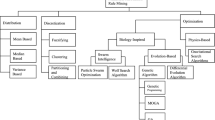Abstract.
Association Rule Mining algorithms operate on a data matrix (e.g., customers \(\times\) products) to derive association rules [AIS93b, SA96]. We propose a new paradigm, namely, Ratio Rules, which are quantifiable in that we can measure the “goodness” of a set of discovered rules. We also propose the “guessing error” as a measure of the “goodness”, that is, the root-mean-square error of the reconstructed values of the cells of the given matrix, when we pretend that they are unknown. Another contribution is a novel method to guess missing/hidden values from the Ratio Rules that our method derives. For example, if somebody bought $10 of milk and $3 of bread, our rules can “guess” the amount spent on butter. Thus, unlike association rules, Ratio Rules can perform a variety of important tasks such as forecasting, answering “what-if” scenarios, detecting outliers, and visualizing the data. Moreover, we show that we can compute Ratio Rules in a single pass over the data set with small memory requirements (a few small matrices), in contrast to association rule mining methods which require multiple passes and/or large memory. Experiments on several real data sets (e.g., basketball and baseball statistics, biological data) demonstrate that the proposed method: (a) leads to rules that make sense; (b) can find large itemsets in binary matrices, even in the presence of noise; and (c) consistently achieves a “guessing error” of up to 5 times less than using straightforward column averages.
Similar content being viewed by others
Author information
Authors and Affiliations
Additional information
Received: March 15, 1999 / Accepted: November 1, 1999
Rights and permissions
About this article
Cite this article
Korn, F., Labrinidis, A., Kotidis, Y. et al. Quantifiable data mining using ratio rules. The VLDB Journal 8, 254–266 (2000). https://doi.org/10.1007/s007780050007
Issue Date:
DOI: https://doi.org/10.1007/s007780050007




